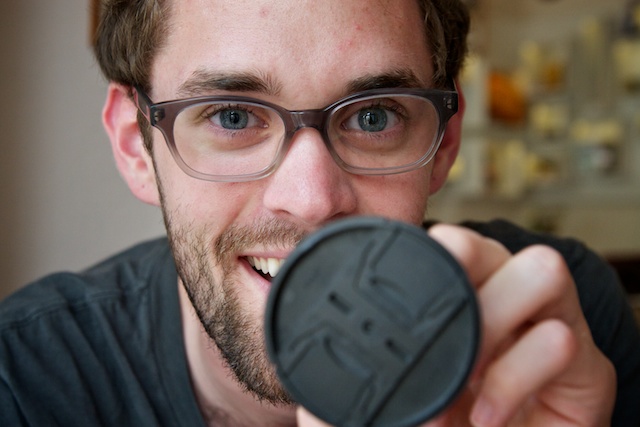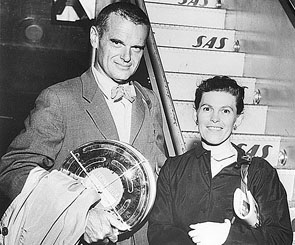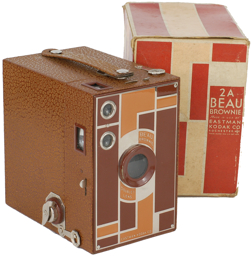 Europe Endless
Europe Endless
Design is a Conversation:
An Interview with Dieter Amick
By Elizabeth Lopeman

DIETER AMICK grew up in Vancouver, Washington, the son of a loving mother and an engineer at Hewlett-Packard. He was naturally drawn to design and technology as well as the arts, spending his early years drawing and experimenting with sculpture and ceramics. After gaining an understanding of the design process behind the creation of every product in the world today, he decided to study industrial design, which led him to Munich, Germany, where he works for a small industrial design firm. Dieter is currently working on an air-conditioning system for a production facility in China, and an e-ink iPhone case.
LOPEMAN: If you could work on your dream project, what would it be?
AMICK: Since I've been working professionally for a little while now, I've come to realize that I really miss the "craft" aspect of product design. I think the industry has really lost its personal, crafted nature in the last twenty years since the advent of the modern computer and product production moving almost exclusively to China. One of the industries I believe that crafted pride remains in is furniture design. I've been thinking about possibly studying furniture design or opening my own furniture studio. This would be my dream job because it would mean not relying on computers to design so much, and it would allow me to manufacture my designs myself and ensure everything is perfect rather than shipping production off to China.
LOPEMAN: Do you think more care translates into products when designers are more involved in the craft?
AMICK: Yeah, and it’s nice when you can build models along the way. I really enjoy that and feel that it helps you understand the design a lot more when you can see it in 3D and you can look at it and touch it and interact with it, and also ask other people and have it critiqued—and also that you’ve made the product yourself. I know a lot of the Danish furniture that’s made is actually built by the designer. And I think that’s really nice and important. It seems kind of strange that someone puts all of this work into the design and then has no part in actually creating the product at the end of the day. Or working with the materials and understanding the materials—it’s a little disconnected. The attention to detail is important, and the story about the product—that it was thought about. It was just an idea before, and then it fully took shape and the same person took the time to complete this and to give it to the consumer. It’s like making an art piece. I really enjoy having a part in every piece of the process. I hate not knowing if it’s going to be made perfectly. If you ship something to China, you have no idea how the product comes out or if the materials they used weren’t up to par. And I think that’s just as important as the shape and the design itself.
LOPEMAN: And that’s really the goal of industrial design, an integrated product that functions with the same standard as the aesthetic?
AMICK: I feel that if the design is good it balances aesthetics, appeal—is it sexy, do I want it?— and functionality—does it work effectively, does it do the task? And then ergonomics is very important. And manufacturability—is it too expensive to make, or did the designer make it extremely difficult to assemble? So all of these things need to be balanced for design to be the best that it should be.
LOPEMAN: Do you come up against conflicts between ergonomics and aesthetics?
 AMICK: Yeah, I guess every day. I guess it’s all the time if you think about that. Making something beautiful but also making it work, because otherwise it’s just something to look at. So really it’s about finding the form that’s beautiful and that fits the use. It’s a balance between art and ergonomics, and if it actually works when you put your hands on it. The Eames’s [pictured left] said something to the effect of, if something functions well it’s inherently beautiful, and that the aesthetics come naturally.
AMICK: Yeah, I guess every day. I guess it’s all the time if you think about that. Making something beautiful but also making it work, because otherwise it’s just something to look at. So really it’s about finding the form that’s beautiful and that fits the use. It’s a balance between art and ergonomics, and if it actually works when you put your hands on it. The Eames’s [pictured left] said something to the effect of, if something functions well it’s inherently beautiful, and that the aesthetics come naturally.
LOPEMAN: What aspects of fine art show up in your work?
AMICK: Fine art plays a big part in designing a product and is always a great place to look for inspiration. I've always thought of artists as very similar to designers in the way that they both are pushing the boundaries in search of the next big thing. A lot of times I find an interesting idea in the fine art world and try to refine and apply it to a design I'm working on, whether it be a material choice or kind of form language.
LOPEMAN: I think it’s an interesting intersection, where art and design come together.
AMICK: Yeah—art, design, and engineering.
LOPEMAN: Because to me the aesthetic is what communicates to the consumer. I mean, it’s critical that a product is engineered properly, but I think it’s the aesthetic that makes it compelling.
AMICK: How it relates to people.
LOPEMAN: Yeah, I think that the first relationship you have is visually with a product and I think that that has more importance than it used to, or that that’s what’s moving the field of design. I think that aesthetics appeal to common people, people who don’t understand or think about the engineering or design. Products hit them emotionally, aesthetically.
 AMICK: I really feel like it’s always been there. Design has always been very strong for hundreds of years. Things have always been designed and it’s always been important to have something that looks beautiful. I think it’s always been important to appeal to the user and communicate and have these human qualities with it. It’s just that now we’ve found a name for it. Walter Dorwin Teague was one of the greats. He started Teague design in Seattle and he was one of the first people to call it "industrial design." But everybody does design every day. You’re an interior designer when you set up things in your house or when somebody knits something for their daughter or son. They’re practicing product design themselves. [At right, "Brownie" cameras designed by Walter Dorwin Teague.]
AMICK: I really feel like it’s always been there. Design has always been very strong for hundreds of years. Things have always been designed and it’s always been important to have something that looks beautiful. I think it’s always been important to appeal to the user and communicate and have these human qualities with it. It’s just that now we’ve found a name for it. Walter Dorwin Teague was one of the greats. He started Teague design in Seattle and he was one of the first people to call it "industrial design." But everybody does design every day. You’re an interior designer when you set up things in your house or when somebody knits something for their daughter or son. They’re practicing product design themselves. [At right, "Brownie" cameras designed by Walter Dorwin Teague.]
LOPEMAN: Does that mean that the idea of design is that the concept is preconceived?
AMICK: Most industrial designers wouldn’t like to hear me say that, but it’s true. I mean some people might think, Well, you need to have a degree—you need to be qualified to practice design. But before cameras were widespread, everybody thought, You have to be a photographer to take photographs. But now everybody is a photographer. Everybody can do graphic design on the computer.
LOPEMAN: Are you influenced by the architecture—the antiquity of Europe—or do you feel you’re focused more on forward thinking design?
AMICK: I do, like a lot of other designers, a lot of forward thinking design research, looking around the Internet for the latest inspiration but I also do a fair amount of looking back through history. I know the American architect, Philip Johnson, did quite a bit of research into the older architecture for inspiration as well.
LOPEMAN: And what about the legacy of architecture and design at the Bauhaus?
AMICK: Yeah, the Bauhaus was not so much about simplicity or efficiency, it was more about bringing art and architecture and design together and experimenting. And there actually is a fair amount of experimentation in design in Germany. It’s funny, people often think the Bauhaus was so serious and stripped down, but it wasn’t really, it was just about experimenting and playing. Another cool thing about the Bauhaus was that they connected it with manufacturing, so a lot of the products that design students created were put into production right there at the school. Building the product and being able to realize it right away was really cool. They were saying that this needs to be able to be made.
LOPEMAN: It had such a short lifespan and it was just this little moment in time, but I think it’s what people think of when they think of German design.
AMICK: Definitely.
LOPEMAN: I think as Americans we always get these products from Germany that say ‘Made in Germany’ and we just go ‘Oh, that’s solid.’
AMICK: Yeah. [Laughs.]
LOPEMAN: You know? It just has such a reputation, right?
AMICK: It has a good history behind it.
LOPEMAN: Well, kind of. Do you know when that started? It was after World War II that they started writing ‘Made in Germany’ on products. It had something to do with Germany receiving war reparations. Because Germany had such a bad reputation, it was mandated that people be made aware that the product they were buying was made in, and ostensibly supporting, Germany. It was stigma, it was punishment in a way. Because someone might have a problem with supporting Germany. And the German response to that was to make totally solid products. But I think that that’s just in the nature of the culture. I really don’t think that was too much of a stretch for them to make quality products, but then it really turned in their favor.
AMICK: Yeah, German design has a very good reputation, for quality, efficiency. And everything that isn’t needed is stripped away.
LOPEMAN: Why did you go into design?
“So my dad had me come into the office and meet some of the designers at HP and they started talking about what they do, drawing a little bit and visualizing how a product could look.”
AMICK: I went into design because my father was an engineer. And I always thought I should do something with engineering. He worked at Hewlett-Packard in Vancouver, Washington, working with Apple products. He was the in-between guy. HP designed some of their printers to be used specifically with Apple computers—printers that matched iMacs and worked well with the software, and had design that spoke to both products, and all that. And he’d always bring home the latest and coolest Mac products and I always was so excited when he came home to see those things, but I had no idea that somebody was actually behind them and thinking about how all those products would look and feel, and what the materials were, and everything about it. I always thought that was an engineer or something. And then I was really into engineering but also art, and I had no idea that there was something that put those together, so my dad had me come into the office and meet some of the designers at HP and they started talking about what they do, drawing a little bit and visualizing how a product could look.
LOPEMAN: How old were you then?
AMICK: Middle school, 5th grade or 6th grade or something. So they showed me around the office and they showed me some sculpted models for concepts—show models, not functional models or anything, and they showed me some cool drawings they did from university. And they had all these design magazines and things to inspire them to think of new shapes. They also had some quick models out of paper and foam board. The design process usually goes from 2D to 3D—a lot from paper to 3D, and then looking at it and then maybe deciding to go back to sketching, and the process just goes back and forth like that. Or even going from the computer and physically making models, too. You can lose scale a lot of times when you’re working on the computer in 3D, though. So, it was a slow process of learning what industrial design actually is. And being sort of afraid, like, ‘Am I the right person?’ because it looked like industrial designers were really creative, and these really artsy people who could draw really amazingly, and they’re always inspiring. But then I started meeting people who are part of the field and realizing there are a lot of different kinds of people in industrial design—and a lot of other design fields. And that’s actually really important, to keep it diverse, because if you have the same kind of people designing, then you get the same answer every time.
LOPEMAN: Yeah, I really like that about the field. The diversity.
AMICK: I think a lot of times firms will make sure they have people with different skills and different specialties. When I was going to school at Western Washington in Bellingham, I learned that they only pick twelve people to go into the program per year, and they make sure it’s a team of twelve and that every year each person has a different skill. They don’t want any overlap, because the idea is that the students are going to learn more from each other than from the professor. They’ll make sure that somebody is really good at building things, that someone is really good at drawing, sketching things out. And there are all these different skills and everybody is helping each other, and when I learned about that I realized that it’s not just one personality or one kind of mind that’s going into design, it’s all these different people.
LOPEMAN: And it’s strengthened because of that, yeah?
AMICK: Yeah—a different kind of team might not work as well together.
 LOPEMAN: I just saw a documentary by Stacy Peralta, Bones Brigade, about how he put together a team of skateboarders, and everyone was really different. Tony Hawk was on the team. Peralta just collected the best kids he could find, and everyone specialized in something really different. And he built this really strong team.
LOPEMAN: I just saw a documentary by Stacy Peralta, Bones Brigade, about how he put together a team of skateboarders, and everyone was really different. Tony Hawk was on the team. Peralta just collected the best kids he could find, and everyone specialized in something really different. And he built this really strong team.
AMICK: And everybody gets better because of it.
LOPEMAN: Yeah—right, exactly. Rodney Mullen was on the team—the guy who developed the Ollie—and he did all these little tricks, riding the nose of the board.
AMICK: He was great at doing little flip tricks and stuff.
LOPEMAN: And he and Hawk were really close, but obviously had really different styles, and in the movie, Hawk talked about being really inspired by the way Mullen rode a skateboard and it helped him with his riding half pipes and pools. And I think that’s nice when situations can become holistic like that.
AMICK: Because if you think about it, if the whole team was like Tony Hawk, they would be really competitive but they wouldn’t learn anything from each other, and they’d probably be butting heads. Yeah. If you have too much of the same it becomes too competitive and everybody starts building walls.
LOPEMAN: And it can’t move forward.
AMICK: But when everybody is different then you don’t have a threat anymore. You know, like, a guy can be the best at one thing and wins in that area no matter what, but his partner is good at something else, and then there isn’t this head to head competition. That can be used in any field, I think. It’s always good to learn new skills and to broaden your horizons and to understand new ways of looking at problems. In talking about design, the answer is not going to come from yourself. You have to talk about it and reflect on it as a team to get the best answers. Design is a conversation, and if you’re thinking about it alone, you’re going to miss some points that someone else might see. It’s important to talk about design and to think about it together.
LOPEMAN: What do you see for the future?
AMICK: I think the next step will be—and it’s been talked about a lot, but it will be far far down the line, maybe fifty years—when 3D printing gets to the point where you won’t go to a store to get a product, you’ll just load the design information to a 3D printer and it will print out whatever you want. Also food and organ printing.
 Elizabeth Lopeman has written for Sculpture Magazine, American Craft Magazine, FiberArts, Bitch, Eugene Magazine, Drain Magazine.com, and various other magazines and websites. She currently lives and works in Munich.
Elizabeth Lopeman has written for Sculpture Magazine, American Craft Magazine, FiberArts, Bitch, Eugene Magazine, Drain Magazine.com, and various other magazines and websites. She currently lives and works in Munich.




